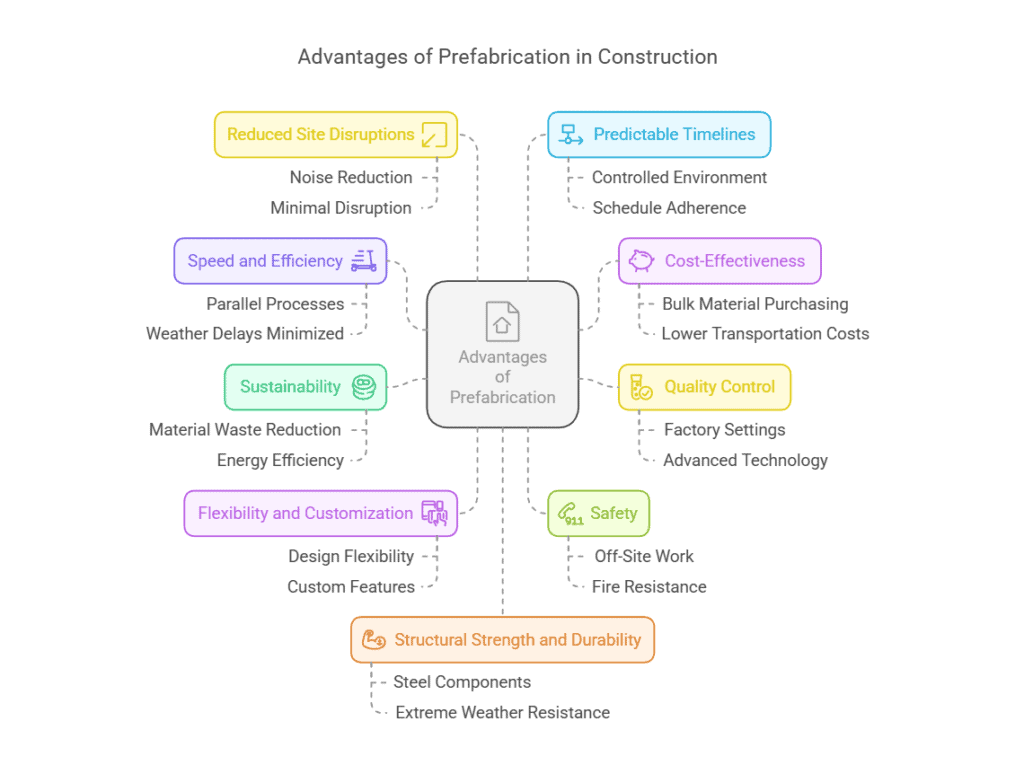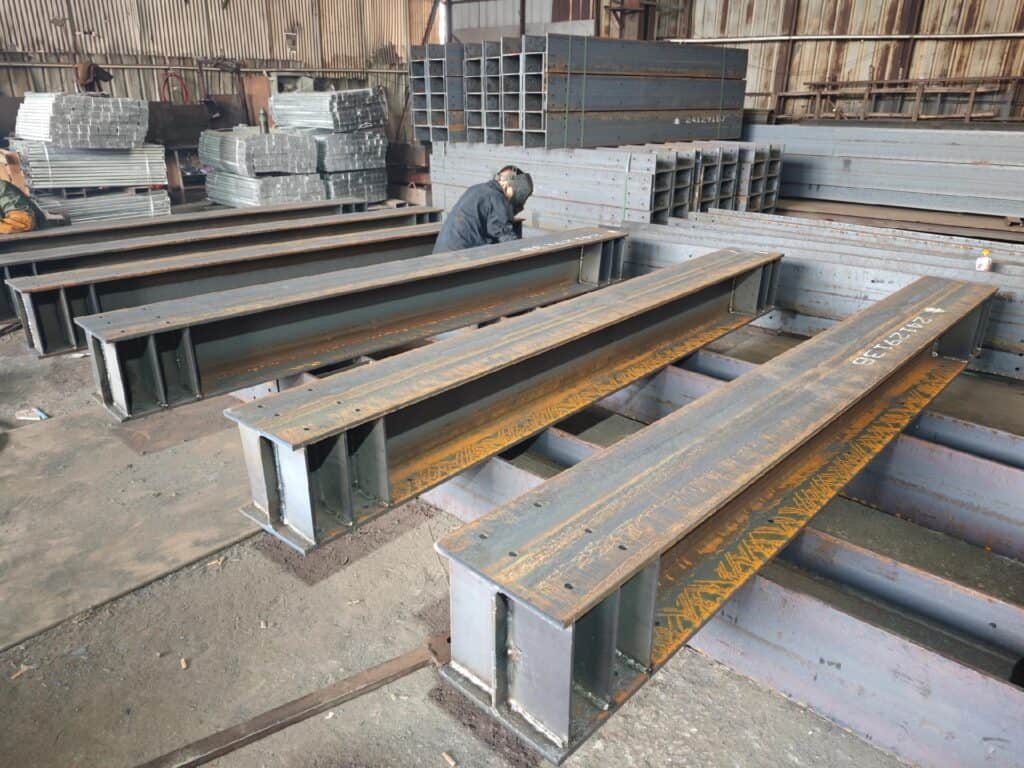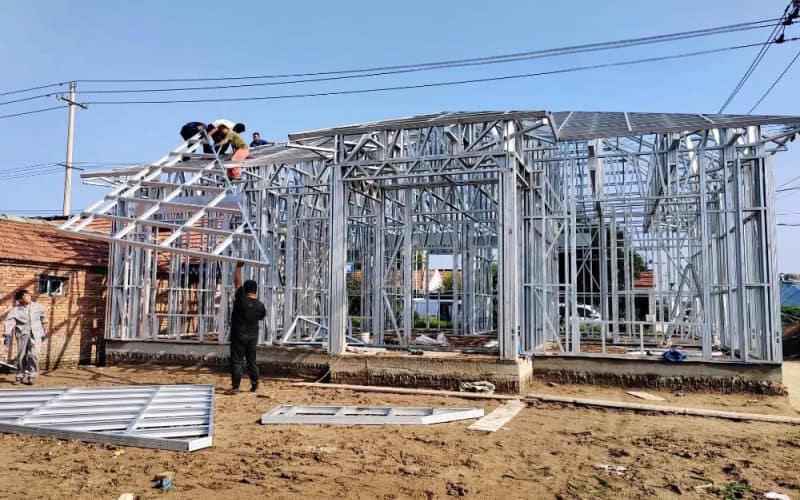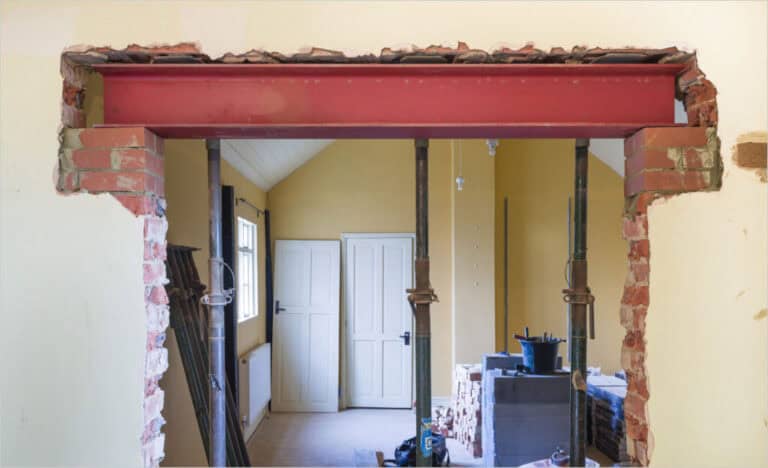The construction industry is moving fast, and prefabrication is leading the way. As a manufacturer of prefabricated steel structures, we’ve seen firsthand how it’s transforming the field—faster builds, smarter designs, and a more sustainable future. And let’s be honest, who wouldn’t want a construction process that’s quicker, cleaner, and more efficient? From residential to industrial projects, prefabrication is redefining modern construction. In this article, we’ll dive into 9 key advantages of prefabrication construction and why it’s becoming the top choice for today’s builders.
What is Prefabrication?
Prefabrication construction, or prefab construction, signifies constructing portions of a structure within a factory rather than at the construction site. These components—spanning from wall sections to entirely modular components—are subsequently conveyed to the building site for rapid installation. Unlike traditional methods, where everything is built from the ground up on location, prefabrication speeds up the process, reduces waste, and ensures greater precision.
Advantages of Prefabrication
Prefabrication construction is faster, cleaner, and more efficient. It’s reshaping the industry with greater precision and less waste. And let’s face it, who wouldn’t desire a more seamless construction process? No wonder it’s gaining traction across all sectors. Here are 9 key reasons why prefabrication is the future of construction.

Speed and Efficiency
Prefabrication accelerates construction by allowing off-site manufacturing and site preparation to happen simultaneously. This parallel process eliminates lag times, in contrast to traditional techniques where each phase is contingent upon the completion of the previous one.
For example, a 12-month project can be completed in just 8 months with prefabrication. Since the majority of work takes place in a regulated factory setting, disruptions due to weather are minimized, thereby guaranteeing consistent advancement. Faster completion also reduces labor costs and financing expenses, making it a smart choice for time-sensitive projects.
Cost-Effectiveness
Prefabrication decreases costs by minimizing material waste, labor expenditures, and project durations. In a controlled factory setting, materials are precisely cut, minimizing excess and eliminating costly on-site adjustments.
Labor costs drop since fewer workers are needed on-site, and shorter timelines reduce financing expenses. With faster completion, investors see quicker returns, making prefabrication a smart, budget-friendly choice for any project.
Additional Ways Prefabrication Saves Money
- Bulk Material Purchasing: Factories buy materials in large quantities at lower costs, reducing overall expenses.
- Lower Transportation Costs: Prefabricated components are shipped in optimized loads, cutting down on fuel and logistics costs.
- Fewer On-Site Delays: Predictable factory production prevents costly weather or labor-related delays.
- Reduced Equipment Rental Fees: Less on-site work means fewer days of expensive machinery and tools.
- Minimal Material Theft or Damage: Factory warehousing safeguards materials from pilferage, vandalism, and climate-induced deterioration.
- Energy Efficiency in Manufacturing: Controlled environments optimize energy use, lowering production costs.
- Less Site Preparation Needed: Prefabrication reduces excavation, grading, and other costly groundwork.
- Lower Waste Disposal Costs: Precision manufacturing leads to minimal scrap, reducing disposal fees.
- Decreased Insurance Costs: Safer factory conditions lower liability risks, reducing insurance premiums.
- Faster Occupancy and Revenue Generation: Shorter build times allow businesses to start operations and generate income sooner.
Quality Control
Prefabrication assures premium quality by manufacturing components in a controlled setting. Unlike traditional construction, where weather delays and human error can cause inconsistencies, factory production follows precise standards, minimizing defects and costly rework.

With high-tech automation and strict inspections, every piece is built for strength, durability, and a flawless finish before it even reaches the site. And let’s be honest—who wouldn’t want a construction process that delivers accuracy you can count on? That’s why prefabrication is the smarter, more reliable choice.
Sustainability
Prefabrication cuts waste and saves resources, making it a smarter, greener way to build. Materials are used efficiently, and extra steel is recycled, not tossed, reducing landfill waste.
Energy-saving features like insulated panels and solar-ready designs lower long-term power use. Plus, with less noise, dust, and disruption, prefabrication makes construction cleaner, quieter, and better for the environment—a win for everyone.
Flexibility and Customization
Prefabrication is anything but one-size-fits-all—it offers endless possibilities for design and function. Whether it’s a modern office, a spacious warehouse, or a multi-story facility, prefabricated structures can be tailored to fit specific needs, styles, and layouts. If you’re considering building one, check out How to Build a Prefabricated House? for a deeper dive into the process.
Need custom dimensions, unique features, or specialized materials? No problem. Prefabrication allows for precision-engineered components that come together seamlessly, making it easy to create exactly what a project demands. It’s flexible, efficient, and built to fit your vision.
Safety
Prefabrication makes construction safer by shifting most of the work off-site. In a controlled factory setting, workers face fewer hazards compared to traditional job sites, where weather, height risks, and heavy machinery increase the chance of accidents.
Once on-site, installation is faster and more efficient, reducing exposure to unsafe conditions. Furthermore, steel frameworks inherently possess fire-resistance and are constructed for durability, providing an additional safeguard. Less risk, more reliability—it’s a smarter way to build.
Reduced Site Disruptions
Conventional construction venues can be loud, disorderly, and a nuisance for everyone in the vicinity. Prefabrication keeps the chaos to a minimum by shifting most of the work off-site, reducing noise, dust, and heavy equipment congestion.
In busy areas like hospitals, schools, and commercial districts, this is a game-changer. Prefabricated buildings go up faster, causing less disruption while keeping daily operations running smoothly. Fewer delays, less mess, and happier neighbors—it’s a win for everyone.
Predictable Timelines
Traditional construction is rife with unforeseen postponements—inclement weather, workforce deficiencies, or supply chain disruptions can disrupt timelines. Prefabrication avoids these setbacks by moving most of the work indoors to a controlled factory environment, where production stays on track no matter what’s happening outside.
With fewer disruptions, projects are more predictable, making it easier for developers to meet strict deadlines and stay within budget. Whether it’s a commercial complex or a residential build, knowing exactly when a project will be completed is a huge advantage.
Structural Strength and Durability
Prefabricated structures, especially those made from steel, are built to last. Unlike traditional construction, where weather, material inconsistencies, and human error can weaken a building, prefabrication ensures uniform quality from start to finish. Every component is engineered under strict standards, guaranteeing strength, precision, and reliability.

These structures don’t just look strong—they perform under pressure. Steel framing can withstand extreme weather, seismic activity, and heavy loads, making it an ideal choice for warehouses, industrial buildings, and high-risk environments. When durability matters, prefabrication delivers a structure that stands the test of time.
Want to know what materials can increase the structural strength and durability of prefabricated buildings? Check out related reading: Materials for prefabricated houses: what types are there and how to choose?
Prefabrication vs. Modular Construction
Though often used interchangeably, prefabrication and modular construction are distinct. Prefabrication covers a wide range of off-site construction methods, from individual components like steel frames and wall panels to larger assembled sections.
Modular construction, on the other hand, creates fully enclosed, self-contained units, often with pre-installed interiors, wiring, and plumbing, ready for on-site assembly. These turnkey modules are ideal for projects that require quick deployment, such as hotels, dormitories, and medical facilities.
Prefabrication offers greater design flexibility, allowing architects to customize layouts and expand structures beyond the limitations of modular units. While both methods improve efficiency, prefabrication adapts to a wider variety of projects, from industrial buildings to large-scale infrastructure.
Why Choose Us as Your Prefabricated Steel Structure Manufacturer?
As a pioneer in prefabricated steel constructions, we contribute expertise, ingenuity, and a client-centric methodology to each undertaking. Our advanced manufacturing capabilities ensure high-quality structures that are both durable and customizable. Whether you require an eco-friendly solution or a distinctive design that distinguishes itself, we have you taken care of. If you’re considering a Prefab Home, our expertise can help turn your vision into reality.Prefabrication is reshaping the construction industry, delivering unmatched benefits in speed, cost, quality, sustainability, flexibility, and safety. As a leading manufacturer of prefabricated steel structures, we take pride in driving this transformation. Our commitment to innovation and sustainability ensures every project we undertake is more than just a building—it’s a testament to modern construction excellence. If you’re ready to explore the future of industrial prefabrication, let’s build something extraordinary together.

